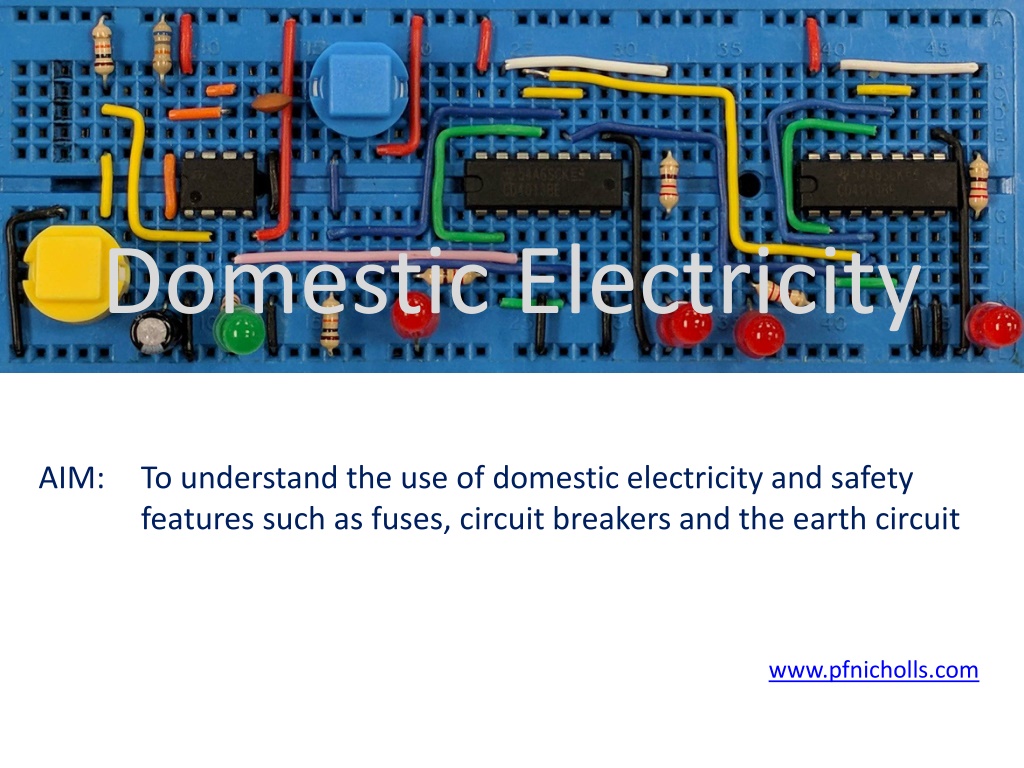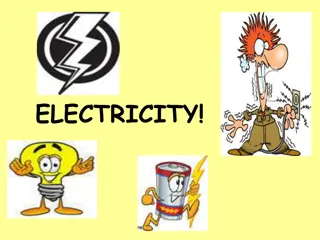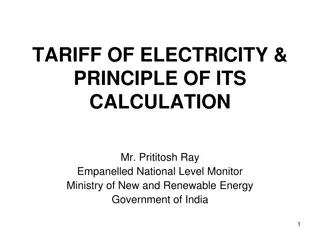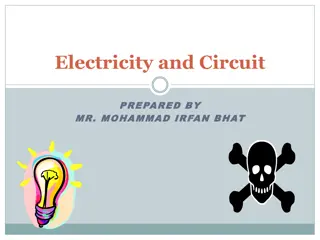Understanding Domestic Electricity and Safety Features
Domestic electricity is supplied to homes at 230 volts and 50Hz. The LIVE, NEUTRAL, and EARTH wires play crucial roles in the electrical system. Circuit breakers and fuses help protect against overloads. Plugs have safety features like color-coded wires and fuses. Understanding these components is key to safely using domestic electricity.
Uploaded on Oct 09, 2024 | 0 Views
Download Presentation

Please find below an Image/Link to download the presentation.
The content on the website is provided AS IS for your information and personal use only. It may not be sold, licensed, or shared on other websites without obtaining consent from the author. Download presentation by click this link. If you encounter any issues during the download, it is possible that the publisher has removed the file from their server.
E N D
Presentation Transcript
Domestic Electricity AIM: To understand the use of domestic electricity and safety features such as fuses, circuit breakers and the earth circuit www.pfnicholls.com
Domestic Electricity The electricity supplied to our homes is a.c. It is nominally 230 volts and has a frequency of 50Hz. The voltage and frequency can change slightly throughout the day as demand changes. The wires that carry electricity into our home are called the LIVE wire and the NEUTRAL wire. There is also an EARTH wire connected to the earth via a large metal spike buried in the ground. After entering the home, the electricity supply first goes through the electricity meter and then to the consumer unit. From the consumer unit there are separate circuits for plug sockets, lights, electric immersion heaters, electric showers, electric cookers and out buildings etc.
Domestic Electricity Picture of a consumer unit showing the circuit breakers for different parts of the house and the main RCCD 32A Socket CB 6A Lighting CB RCCB 40A Shower Circuit Breaker
Domestic Electricity The black cable is the Live and Neutral to the house, this goes through the electricity meter and then to the consumer unit Connection to consumer unit for distribution round the house Electricity board 60A main fuse Main Live and Neutral connections to the house. The outer shield provides an Earth connection (just visible) Old Style Electricity meter
Domestic Electricity The red Live wires each go to a circuit breaker. The Earth connections all join together at the top. The black Neutral wires all connect together at the side (hard to see). Main supply goes to RCCB first.
Plugs The standard domestic plug is shown opposite. The LIVE wire is BROWN The NEUTRAL wire is BLUE The EARTH wire is YELLOW & GREEN stripes The FUSE is in the Live wire Cord grip prevents the cable being pulled out of the plug The plug can not be used with the top removed because all the pins fall out if you try to plug it in
Plugs There are a few extra safety features visible in this picture of a standard plug. The Earth pin is the longest so that it goes in first and comes out last. The Earth pin opens the shutters in the socket that protect the Live and Neutral connections. The Live and Neutral pins have tape around them so that little fingers can t make contact when you pull the plug out children tend to wrap their fingers behind the plug to pull.
Fuses A fuse is a thin piece of wire included in a circuit. The material from which the fuse wire is made usually has a lower melting point and a slightly higher resistance than the other wires in the circuit. If too much current flows in the circuit, the fuse wire will get hot (due to its higher resistance) and melt (due to its lower melting point) before any of the other wires get hot. Once the fuse melts, the circuit is broken and no more current flows. Domestic fuses are rated at 3A, 5A and 13A for use in plugs and 6A, 16A, 32A, 40A for use in consumer units. Many appliances, such as TVs etc, also contain internal fuses with an even lower current rating.
Fuses Left: 13A, 5A and 3A domestic fuses found in plugs Right: fuses found inside appliances the small ones are 500 mA Bottom: Automobile fuses, sometimes called blade fuses. These come in multiples of 5A the yellow ones are 20A
Circuit Breakers A circuit breaker does the same job as a fuse it breaks the circuit if too much current flows. A circuit breaker is an electro- mechanical device. It uses an electromagnet to move a mechanical switch when the current is too high The advantages of a circuit breaker are: They disconnect the circuit quickly They can be reset easily 40A Higher power devices such as cookers or showers 32A Sockets on a ring main 6A Lighting circuits
RCCB If a fault occurs, or a person gets an electric shock, a small amount of current flows from Live to Earth this is the residual current. The current in the Neutral wire is less than the current in the Live wire. A Residual Current Circuit Breaker (RCCB) detects the small difference in current in the Live and Neutral and disconnects the electrical supply. An RCCB is very fast, disconnecting the supply in just a few milliseconds. The device shown is also the main Circuit Breaker rated at 100A total for the whole house. The residual trip current is shown as 0.03A (30mA).
Earth Circuit The Earth wire is not necessary for the circuit to work. In normal operation, current flows along the Live and Neutral wires and the earth wire is connected to exposed metal parts of the appliance. If a fault occurs and the Live wire touches the metal parts of the appliance, it is possible for the user to receive an electric shock. However a large current flows through the Live, along the Earth wire and to ground. This large current blows the fuse. The Earth wire is only effective when used with a fuse. The Neutral wire is less dangerous as it is always at a low voltage where as the Live wire is at a high voltage. This is why the fuse is always in the Live wire.
Earth Circuit The circuit is working properly, there is no fault. Current flows in the Live and Neutral wires - the element glows. No current flows in the Earth wire, the person is not electrocuted and the fuse doesn t blow.
Earth Circuit The circuit has a fault. The Live wire is touching the metal kettle and the person will receive an electric shock. However, a large current now flows along the Earth wire. This current is enough to blow the fuse and disconnecting the electrical supply.
Earth Circuit The circuit has a fault and no Earth wire. The Live wire is connected to the metal case of the kettle and the user will get an electric shock. The small extra current through the person is not enough to blow the fuse. The kettle remains connected to the electrical supply and is a danger to the user.
Double Insulation Not all appliances need an Earth wire. If there are no exposed metal parts then there is no risk of the appliance being live in the event of a fault. Such appliances are called Double Insulated because there are two layers of insulation one around the wire, the other around the case itself. Double Insulation Symbol and example of a double insulated power supply Note the plastic Earth pin, it is still necessary to open the shutters in the socket
Summary Domestic electricity is supplied at 230v The wires in a domestic appliance are Live (brown), Neutral (blue) and Earth (green & yellow) Fuses and circuit breakers disconnect the electrical supply when too much current flows. Circuit breakers can be easily reset The fuse or circuit breaker is always in the live wire The earth wire blows the fuse in the case of a fault and so prevents the user receiving a shock if the metal parts of an appliance are live RCCBs cut off the electrical supply if a person is being electrocuted or some other fault occurs where current flows to ground
Questions 1. What are the advantages of a circuit breaker over a fuse 2. What is the difference between a circuit breaker and an RCCB? 3. How can a fuse and earth wire protect against electric shock 4. What are 3 wires found in a plug? What are their colours?
Answers 1. A circuit breaker is: Faster Can be easily reset More accurate 2. A circuit breaker protects against excess current and the risk of fire, an RCCB protects against being electrocuted 3. If there is a fault and the live wire touches the metal case of an appliance, the earth provides an easy path to ground and a massive current flows. This blows the fuse. 4. Live Brown, Neutral Blue, Earth Green and Yellow























